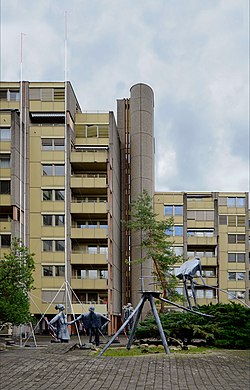Wydäckerring settlement
| Wydäckerring settlement | |
|---|---|
 |
|
| Data | |
| place | Zurich |
| architect | Kuhn + Stahel |
| Client | Mobal AG, HIG Foundation, Aeberlis Erben |
| construction time | 1971-1976 |
The Wydäckerring residential development is a building complex in Zurich built between 1971 and 1976 . It comprises a total of 313 residential units, which are mainly composed of one and two-room apartments. The low one-room apartments in the north are former staff houses of the Triemli Hospital and form a unit with the row of up to 9-story houses in the south of the plot.
location
The settlement is located in the immediate vicinity of the Triemli Hospital in Albisrieden , on the border with Wiedikon. The development is part of a development phase that was implemented along the express route planned at the time between the Triemli and the Sihlfeld cemetery . The planned road connection, however, developed into a pedestrian path, which now ties together a remarkable ensemble of prefabricated buildings from the post-war period.
history
The settlement was planned in 1971 by the architects Kuhn + Stahel and executed by Ernst Göhner AG. The development is an example of the architecture of the 1970s with an exemplary character. The handling of the floor plans is systematic, with prefabricated components from the catalog and other prefabricated elements being used. The spatial constellation follows the principle of the «city within the city», where the settlement is viewed as a self-contained unit that is intended to offer the residents a livable environment. The architecture is related to a larger-scale approach in Zurich's urban development, which, under the influence of the large population growth of the 1970s, advanced towards increased density, and which finally culminated in the first Zurich high-rise boom at the end of the 1970s.
Niklaus Kuhn , the architect of the Wydäckerring housing estate, was a member of the Zurich Working Group for Urban Development (ZAS), which, as a leading group, had its influence on urban development in the Zurich region. In addition to Niklaus Kuhn, other representatives of Zurich's late modern era such as Eduard Neuenschwander , Beate Schnitter and Benedikt Huber were members of the ZAS. In the context of this discourse, settlements have sprung up scattered across the greater Zurich area that are related to that of the Wydäckerring in terms of approach and density.
Since the renewed economic upswing after the financial crisis in 2008, the settlement has been under increased pressure to renew. There are plans to give way to a replacement building.
Individual evidence
- ^ Brunhild Hammer: Illustrated Chronicle 1966–1982 of the Building Authority II of the City of Zurich. Orell-Füssli, Zurich 1982.
- ↑ District mirror Albisrieden
- ↑ Benedict Huber: The city vision of ZAS and its importance for Zurich. In: Zurich working group for urban development 1959–89: a documentation. 2000.
- ↑ Wydäckerring Duplex Architects development project , 2019